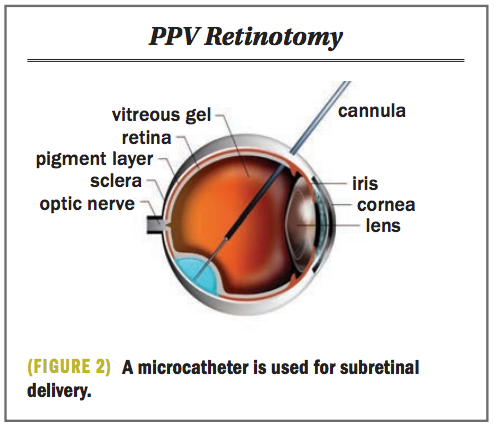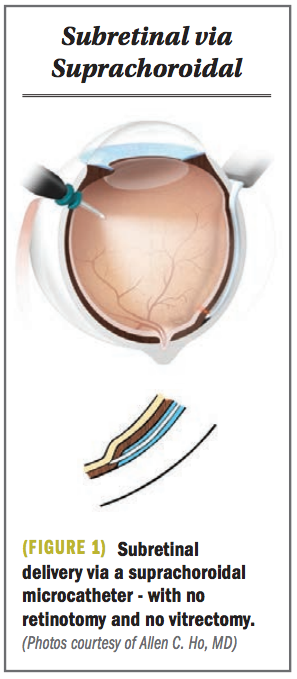News
Article
Research targets precision dosing for gene, cell therapy
Author(s):

New surgical techniques offer improvements in the precision and safety of gene and cell therapy delivery to target tissue.
This article was reviewed by Allen C. Ho, MD, and M. Ali Khan, MD
Gene therapy is happening today and cell therapy may soon follow, according to Allen C. Ho, MD.

Dr. Ho, professor of ophthalmology, Thomas Jefferson University, and director of retina research, Mid Atlantic Retina and Wills Eye Hospital, Philadelphia, and his colleagues have been focusing on improving the consistency and precision of therapeutic delivery to target tissues.
“Subretinal delivery provides direct surgical access to target retinal pigment epithelial cells and retinal photoreceptors,” he said. “This direct access may be important for gene and cell therapies for treating retinal diseases.”
The first FDA-approved gene therapy is voretigene (Luxturna, Spark Therapeutics) for biallelic RPE65 mutation-associated retinal dystrophy. In addition to restoring vision to patients, the studies evaluating the efficacy of voretigene (among other gene therapy studies) have established the safety and feasibility of subretinal delivery of gene therapy.
The use of gene therapy for other retinal diseases, such as neovascular age-related macular degeneration (AMD), are currently in clinical trials.
According to Dr. Ho, translational scientists are working on improving viral capsids and transgene selections to improve efficacy. In this aim, Dr. Ho and colleagues are hoping to improve the consistency and precision of delivery systems for gene and cell therapy.
Methods of drug delivery
Subretinal delivery is achieved in a few ways, the most familiar of these is “transretinal” via pars plana vitrectomy (PPV) and retinotomy using a microcatheter.
Another approach is subretinal delivery via the suprachoroidal space.
In this method, Dr. Ho explained, a flexible microcatheter follows the curvature of the sclera and a microneedle, which is under the visual control of the surgeon, enters the subretinal space without the need for a PPV and retinotomy.
“A new intriguing way of transfecting target tissue is suprachoroidal injection therapy,” he said. A major advantage of such a treatment would be the potential ability to perform the procedure in the office setting.
Gene therapy clinical trials
A Phase I/IIa gene therapy clinical trial by RegenexBio for neovascular AMD is currently under way. Enrolled subjects have been treated for neovascular AMD previously and needed frequent anti-VEGF injections over years; he described one subject who needed 21 monthly injections of ranibizumab (Lucentis, Genentech). In the study, a high-affinity AAV8 viral vector that encodes for an anti-vascular endothelial growth factor protein that is similar to ranibizumab is injected into the subretinal space, Dr. Ho explained.
The surgery is performed as follows. A core vitrectomy is performed. A 41-gauge internal diameter microcatheter is then used to deliver the vector into the subretinal space.

This maneuver is performed outside of the macula about two disc areas away from the neovascular lesion. An air-fluid exchange is performed. The traditional eye drops are instilled; no systemic steroids are used in the subretinal injection procedures.
“We have seen very good safety data for this surgical procedure,” Dr. Ho reported.
Improvement in the precision and control of subretinal delivery has been achieved using a new tool, the MicroDose injection kit (MedOne Surgical Inc.) that includes a 1-cc microcalibrated syringe that is hooked up to the viscous fluid injection system.
“The surgeon has foot pedal control of precise volumes of fluid injected into the subretinal space,” Dr. Ho noted. “To control any surgeon variability, all procedures, i.e., vitrectomy and subretinal injection, are standardized and automated, and the surgical videos of all surgeons are reviewed in order to improve the techniques and standardize them.”
Suprachoroidal delivery
Cell therapies to replace retinal pigment epithelium cells for the treatment of advanced geographic atrophy in dry AMD are under investigation. Replacement RPE cells may be delivered on a synthetic sheet or in suspension delivered into the subretinal space via a surgical procedure involving PPV and retinotomy formation, according to Dr. Ho.
Potentially complicating these cell therapies is the possibility of scar tissue formation, including epiretinal membrane formation or proliferative vitreoretinopathy-related tractional retinal detachment.
“Complications from proliferative vitreoretinopathy will be a topic of interest for treating retinal specialists. The retina community will be watching this as new cell therapy-related trials are initiated,” said M. Ali Khan, MD, assistant professor of ophthalmology, Thomas Jefferson University and Wills Eye Hospital.
The investigators hypothesized that these complications are the result of egress of delivered cells through the retinotomy on to the surface of the retina.
“That failure stimulated development of multiple approaches to reach the subretinal space.
A suprachoroidal microcatheter was developed with a flexible microneedle; this needle emanates into the subretinal space to create a detachment and deliver cells.
The advantages are that no vitrectomy and retinotomy are needed, there is no efflux, and as a result the dosing might be more precise and consistent,” Dr. Ho commented.
The procedure begins with insertion of a chandelier light source. A sclerotomy is fashioned 6 mm posterior to the surgical limbus after conjunctival peritomy is performed.
A microcatheter is then inserted via the sclerotomy into the suprachoroidal space after being held in place with scleral sutures (microloops) to stabilize the path of the microcatheter and to reduce the amount of internal catheter movement to avoid damage, Dr. Khan described.
When the microcatheter is visualized to be in the desired location, a microneedle is advanced into the subretinal space. A saline bleb confirms the location. Cells are then delivered.
This technology, developed by Gyroscope, has received 2019 FDA approval and is being used in the Lineage (formerly BioTime) cell therapy trial for atrophic AMD.
Dr. Ho pointed out the importance of three-dimensional (3D) imaging in reaching the correct subretinal space with precision and safety. “3D imaging allows measurement of dosing, which is an important metric in a clinical trial,” he commented.
“Gene and cell therapy is happening,” he added. “Subretinal delivery of therapy via a vitrectomy and retinotomy is very familiar.”
However, the dosing can vary and efflux can occur, especially in cell therapy trials.
“The suprachoroidal approach has been approved by the FDA and is being used in an AMD clinical trial. Imaging will be important and we now have three-dimensional imaging to facilitate quantitative dosing,” Dr. Ho summarized.
Allen C. Ho, MDE: achomd@gmail.com
Dr. Ho is a consultant to AGTC, Asclepix, Gyroscope, Iveric/Ophthotech, Lineage/BioTime, and RegenexBio.
M. Ali Khan, MDE: makhan@midatlanticretina.com
Dr. Khan has no financial disclosures related to this subject.
Newsletter
Don’t miss out—get Ophthalmology Times updates on the latest clinical advancements and expert interviews, straight to your inbox.




